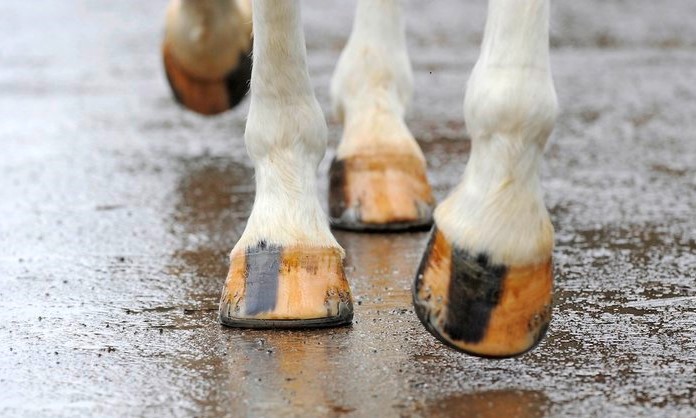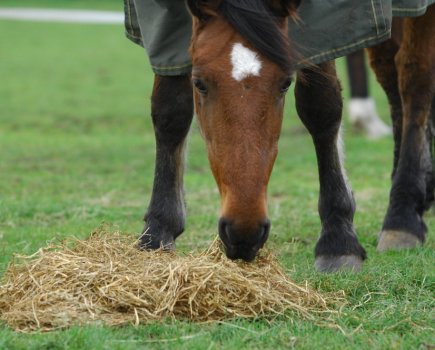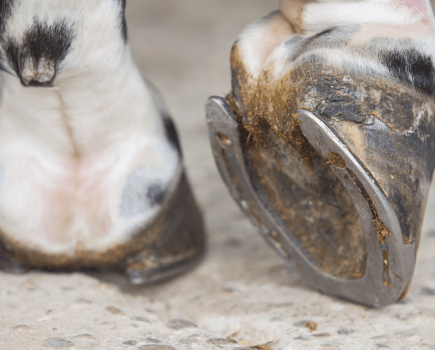We all know how painful it is when we stand on a stone without our shoes on, and although our horse’s feet are tougher than ours, they can also suffer from painful bruising due to standing on a hard object. A bruised sole can be a very painful injury that requires time off and medical management. Bruised soles are a common cause of lameness in both shod and barefoot horses, so are an important aspect of hoof care to be aware of.
Injury to the sole can damage the underlying sensitive structures, resulting in bruising. This is due to damage to tiny blood vessels beneath the sole and subsequent bleeding. Sometimes a bruised sole doesn’t show up straight away and if your horse isn’t particularly lame, you may miss it altogether and become aware of the bruising only when alerted by your farrier on their next visit.
With removing the cause, and initiating rest and anti-inflammatory medication, a bruised sole can resolve quickly and cause no further problems. However, should a haematoma, also known as a blood blister, or abscess develop, the pressure caused by the blood or infected material (pus) within the hoof will cause pain and lameness. Such patients can have a slower resolution and require further treatment in the form of draining the accumulated blood or pus.
Bruised soles in horses: common causes
In simple terms, a bruised sole is caused by inflammation and bleeding of the subsolar (underside) surface of the horse’s foot. Any accidental injury to the sole of the foot, such as treading on a stone or another hard object, can result in the development of a bruise.
Poor-fitting shoes and/or excessive work on hard ground, especially when unshod, can also cause solar trauma. Horses with thin soles are more predisposed to bruising, as are those with short heels and long toes as the sole is closer to the ground and more likely to come into contact with objects.
Horses that suffer from laminitis may also present with solar bruising. Bruises in the sole can develop into abscesses when bacteria find their way into a subsolar bleed and cause infection. The pressure that builds as the pus accumulates can make the horse severely lame.
Signs of a bruised sole
Finding the bruise early facilitates prompt management and a quicker resolution of clinical signs. Horses suffering from bruised soles often present with varying degrees of lameness and sometimes red or brown discolouration, indicating bruising, is evident when the sole is examined. There can also be heat in the foot and an increased digital pulse, and some horses will react when hoof testers are applied at the site of the bruising.
Most commonly, an affected horse may become suddenly lame or may be intermittently lame for a few days, and the lameness usually affects one leg although multiple limbs may be affected concurrently.
How to treat a bruised sole
If a bruise is confirmed or suspected, attempts should be made to try and identify the cause. This may assist with treatment and in the prevention of future bruising. Sometimes the cause is easy to identify and remove, such as when a stone is stuck in the hoof. In cases where a bruise is suspected due to an ill-fitting shoe, the shoe should be removed.
If a bruise or abscess is suspected due to sensitivity on hoof testers, but there is no overt bruising evident, the sole should be carefully pared. Solar paring is contra-indicated if bruising is suspected to have occurred secondary to laminitis.
On confirming the bruise, affected horses should be box-rested and given pain relief in the form of non-steroidal anti-inflammatories. In those horses with haematomas or abscessation, drainage should be established and a poultice subsequently applied to draw any infected material from the site.
An X-ray examination should be considered for severely affected horses to rule out other conditions such as fractures of the pedal bone. Bruising resolves within a variable time-frame but uncomplicated cases generally resolve within two weeks.
Six ways to prevent bruised soles
To help ensure your horse doesn’t suffer from bruised soles, you can do the following:
- Avoid working them excessively if the ground is hard.
- Always pick out their feet before and after work.
- Manage your paddocks correctly by harrowing and rolling when suitable, to flatten uneven ground. Large stones should be removed.
- Speak to your farrier if you are concerned about your horse’s foot balance, and if bruised soles are caused by laminitis, contact your vet.
- Protective hoof pads are sometimes used for thin-soled horses to prevent bruising, although they should be used with care and after consulting your farrier and/or vet.
- Hoof hardeners can help ‘harden’ soft soles but again, care should be exercised, and they should be used only on the advice of your farrier or vet.
Case study: ‘All bar one of my horses went lame’
When Holly Stewart ran a yard filled predominantly with Thoroughbreds, a new track being laid in her local forestry triggered lameness…
“The forest was right by the yard and we did most of our hacking in there because the main road was so busy during the week. But when the new stone track went down, all bar one of my horses became lame due to bruised soles. One was so severely affected that we had to stop riding him in there altogether.
“Each horse was already receiving biotin in their hard feed, and an iodine/sugar paste was being applied to the soles of their feet. I discussed using pads with my farrier, and for the two horses who particularly struggled this was our only option. However, if anything this made their soles softer and it made them prone to pulling off a shoe at the first sight of mud — and it gets very wet in the West Country!
“All horses stopped hacking in the forest until bruising had subsided. After that, we just had to be very careful. Walking only, trying to go around the worst affected areas and using the forest less, which was a shame. We also had to be really on top of our hoof care to help the soles be as hardy as possible.
“Luckily, once the track had bedded in we stopped noticing as many problems with bruised soles, but it took a good eight months to get to that stage.”








